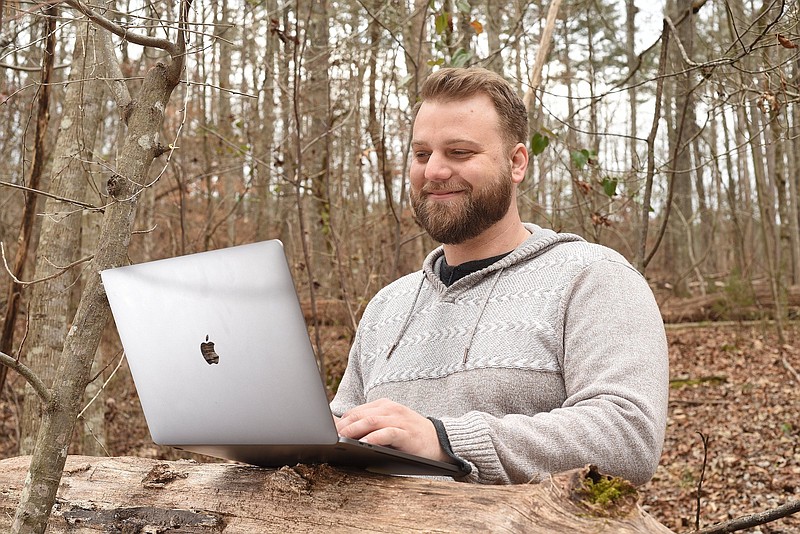Their 12-and-a-half acre homestead in Villanow, Georgia, is the perfect place for Joe Hader's growing family, his home-based business, and his outdoor inclinations, but Hader wasn't always sure it would work out.
"I'm in video production and marketing, so I need so much internet it's ridiculous," says Hader, who moved to Walker County, Georgia, from Austin, Texas, two years ago. "It was a major consideration, and when we first checked out the house I couldn't even make phone calls from where I was."
Hader rigged up a solution by working with AT&T, which has a cell tower on a nearby ridgeline, to get a high-speed mobile hotspot for his Zoom calls and video uploads. It has worked out, but now fiber internet is on the way via a $6.2 million grant awarded to Walker County by Georgia's Broadband Infrastructure Committee – plus more than $5 million in matching funds from rural utility provider Kinetic by Windstream.
"We have so much going on across the state," says Michael Foor, president of Georgia state operations for Kinetic by Windstream. The company, which is an aggregation of utilities that began as small, rural telephone providers, covers 18 states, Foor says.
"Windstream has about $2 billion committed to invest in our footprint, and we're budgeting that cash out by looking at how to match that with other opportunities, such as the state fiscal recovery funds and RDOF (the Rural Digital Opportunity Fund) and the federal infrastructure bill," Foor says. "We have 10,000 employees, but we still are a rural provider, and our employees live in these rural areas and serve them."
Improving internet access for rural areas has long been a priority, but the pandemic ratcheted up the urgency of the work, and a windfall of resources has enabled investments that would otherwise be financially untenable, says Taylre Beaty, state broadband director for the Tennessee Department of Economic and Community Development.
"The state and federal government invest in broadband infrastructure because it lessens the burdens for providers in their build-out plans and gives them a better business case," Beaty says. "It gives them opportunities to access capital support and fund a portion of the build-out for these areas where no one is going to serve them anytime soon."
The $1 trillion federal infrastructure plan includes $65 billion to improve internet services for rural areas, low-income families and tribal communities. Most of the money will be made available through grants to states. In Tennessee, Beaty's department has $400 million for broadband infrastructure through federal pandemic aid programs, and is accepting applications through mid-March from internet providers seeking to expand internet access to unserved and underserved areas, Beaty says.
Photo Gallery
Online anywhere: Rural broadband gets a boost from pandemic funds and work-from-home demand
"Anybody who is authorized to provide broadband services in Tennessee is able to apply," she says. "There are speed requirements for the build-out side, but anybody can apply."
High-speed internet access is an essential element for attracting new businesses and residents to rural communities, but the pandemic has made it a must-have for everything from education to medical care, Beaty says.
"It's something that 10 years ago you probably could have gotten by without an internet connection, but today, and especially after the pandemic, people need to work from home, access health care and education," she says. "You just can't do that without an internet connection."
Work from (almost) anywhere
The pandemic opened up a world of work-from-home possibilities that prompted people to consider moving to smaller towns and far-flung communities, and the Hader family was on the leading edge of that trend. In the early days of the pandemic, stuck in a small house with three kids just outside of Austin, the Haders quickly began longing for legroom, Joe Hader says.
"One of the perspective shifts for a lot of people was the trials of having kids in your house when you're working," says Hader, whose children are now 9, 7 and 4 years old. "It was such a small house, such a small yard – what are we supposed to do with these kids?"
According to a Gallup poll, 48% of Americans at the end of 2020 said they would choose a town or rural area rather than a city or suburb if they could live anywhere they wished. Just a few years ago, in 2018, 39% thought a town or rural area would be ideal.
But the work-from-home movement only reaches as far as the broadband network, says Charlie Boring, the general manager of Bledsoe Telephone Cooperative, which in 2016 launched an aggressive push to get fiber rolled out across Bledsoe and Sequatchie counties in Tennessee.
"The growth of this area is unbelievable now," Boring says. "People realize you can get good broadband in these areas and work from home."
Bledsoe Telephone Company, working as BTC Fiber, has a little over 10,000 customers in 800 square miles, and has prioritized getting fiber to every home in their service area, starting with the more populated towns of Dunlap and Pikeville, Boring says.
"We are probably about 40% complete on our fiber-to-the-home network, but we only have like 20% or 30% of our customer base left in that 60% [of the service area] – it's the most expensive areas we're doing now," Boring says. "At this point, we probably have about 12 people per mile of line we build."
Count Kelly Summersett and her wife, Candace Clackner, among them. They had lived for years in neighborhoods close to downtown Chattanooga, but hoped to one day build a house in the woods. The women spent two years searching for the perfect property in the region.
"There were some places where that was always the first thing we would check – how's the internet here?" Summersett says.
The 10 and-a-half remote acres in Sequatchie County where they moved in November came with trees, a creek, a view and – critically – fiber internet, Summersett says.
World Wide Web
While broadband adoption has not significantly increased for urban and suburban Americans in the last five years, rural residents have seen a 9 percentage point rise in home broadband adoption since 2016, when about six-in-ten (63%) reported having a high-speed internet connection at home. Roughly seven-in-ten rural Americans (72%) say they have a broadband internet connection at home, according to a Pew Research Center survey of U.S. adults conducted from Jan. 25 to Feb. 8, 2021.
"Where we are is new ground for all the utility companies, so Bledsoe [Telephone Cooperative] had to come out and do a lot of digging and put a lot of fiber down just for us," she says. "They were like, 'Yeah, sure.' They were so helpful and easy to work with and timely."
Bledsoe Telephone Cooperative taps a wide range of state and federal resources to make it all work, and the utility plans to have 100% fiber to homes in its coverage area by the end of 2024, Boring says.
"In some of these areas, you're talking about $32,000 per mile to get it on the poles, and anywhere from $1,500 to $2,000 to get from that pole to the customer's house," he says. "Our total investment when we looked at this to do out entire area is probably $60 million to $70 million."
Financial partnerships are crucial to making the math work in bringing broadband to rural areas, Beaty says.
"We've got a lot of really great providers across the state that want to be creative and scrappy and solve the problem and serve their community," she says.
In addition to the challenges of paying for broadband, there are big hurdles in mapping the need across regions to get a holistic view, says Shannon Millsaps, director of operations for Thrive Regional Partnership, which focuses on fostering responsible growth across a 16-county area.
"The data that does exist as far as address-level service is not accurate, it's historically unreliable," Millsaps says. "It's self-reported by providers."
In June, Thrive launched the Regional Broadband Alliance, a group of more than 40 organizations and individuals interested in expanding equitable access to high-speed internet across the region. In addition to supporting efforts to expand broadband, the group focuses on affordability for people who live in areas where broadband is available but resources are scarce.
"The most recent federal infrastructure bill has a lot of funding built in for broadband expansion, for digital literacy and equity programs – we want to make sure folks in our counties have the information they need to take advantage of those dollars," Millsaps says.
Broadband access is a crucial, universal tool for economic development, but every community will face different challenges in expanding access, she says.
"When you talk about everywhere from South Pittsburg to Chattanooga to Benton, there's such a wide range of those ground-level community needs," Millsaps says. "Collaborative partnerships are key and each community is different."
READ MORE
* Good bones: New life for old buildings revives small-town downtowns
* Made here: Counties around Chattanooga are magnets for manufacturing

